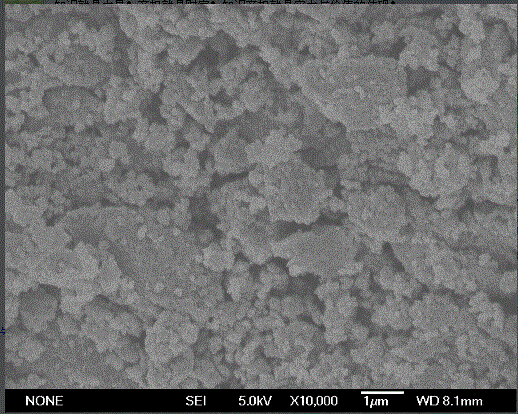Preparation method and application of graphene oxide-loaded titanium dioxide coupling material
A technology of titanium dioxide and graphene, applied in chemical instruments and methods, special compound water treatment, physical/chemical process catalysts, etc., can solve problems such as environmental and human health hazards, and achieve convenient operation, simple operation, and wide source of raw materials Effect
- Summary
- Abstract
- Description
- Claims
- Application Information
AI Technical Summary
Problems solved by technology
Method used
Image
Examples
Embodiment 1
[0018] A method for preparing the graphene oxide supported titanium dioxide coupling material of the present invention, the specific steps are as follows:
[0019] Mix 6 g graphite powder, 5 g K 2 S 2 O 8 And 5 g P 2 O 5 Add to 24 mL of concentrated sulfuric acid with a mass concentration of 98% and react at 80 ℃ for 4.5 hours. After cooling to room temperature, add 1000 mL of ultrapure water. After standing for 12 hours, the product will be washed to neutrality and then at 60 ℃. Dry to obtain pre-oxidized graphene; add the obtained pre-oxidized graphite to 240 mL of concentrated sulfuric acid with a mass concentration of 98%, and then add 5 g of NaNO 3 And 30 g KMnO 4 , React for 4 hours at 0 ℃, react at 35 ℃ for 2 hours, add 500 mL ultrapure water, react at 98 ℃ for 1 hour, then add 1000 mL ultrapure water and 40 mL concentrated H at room temperature 2 O 2 , Continue the reaction for 2 hours, wash the obtained product with HCl solution with a mass concentration of 10%, wash with ...
Embodiment 2
[0023] The graphene oxide supported titanium dioxide coupling material of the present invention is used for photocatalytic removal of hexavalent chromium in wastewater, including the following steps:
[0024] Take 1000 mL of hexavalent chromium wastewater with a mass concentration of 10 mg / L, adjust the pH value of the hexavalent chromium wastewater to 1-8 with negligible volume of sodium hydroxide or hydrochloric acid, and add 0.5 g to the above-mentioned hexavalent chromium wastewater Graphene oxide supported titanium dioxide coupling material, so that the mass concentration of the coupling material in the solution is 0.5 g / L, and the graphene oxide supported titanium dioxide coupling material is fully contacted and reacted with hexavalent chromium wastewater for 1 hour under the condition of no light irradiation. The temperature is 25 ℃, then the UV lamp covered with quartz glass is placed in the hexavalent chromium wastewater, and the wastewater is fully stirred and reacted fo...
Embodiment 3
[0029] The graphene oxide supported titanium dioxide coupling material of the present invention is used for photocatalytic removal of hexavalent chromium in wastewater, including the following steps:
[0030] Take 1000 mL of hexavalent chromium wastewater with a mass concentration of 10 mg / L, adjust the pH value of hexavalent chromium wastewater to 2 with negligible volume of sodium hydroxide or hydrochloric acid, and add 0.1 and 0.5 to the above-mentioned hexavalent chromium wastewater respectively , 1 g of graphene oxide is loaded with titanium dioxide coupling material, so that the mass concentration of the coupling material in the solution is 0.1, 0.5, 1 g / L, respectively, and the graphene oxide is loaded with titanium dioxide coupling material and hexavalent chromium under the condition of no light irradiation The wastewater is fully contacted and reacted for 1 hour, the reaction temperature is 25 ℃, then the UV lamp covered with quartz glass is placed in the hexavalent chrom...
PUM
 Login to View More
Login to View More Abstract
Description
Claims
Application Information
 Login to View More
Login to View More - R&D
- Intellectual Property
- Life Sciences
- Materials
- Tech Scout
- Unparalleled Data Quality
- Higher Quality Content
- 60% Fewer Hallucinations
Browse by: Latest US Patents, China's latest patents, Technical Efficacy Thesaurus, Application Domain, Technology Topic, Popular Technical Reports.
© 2025 PatSnap. All rights reserved.Legal|Privacy policy|Modern Slavery Act Transparency Statement|Sitemap|About US| Contact US: help@patsnap.com

